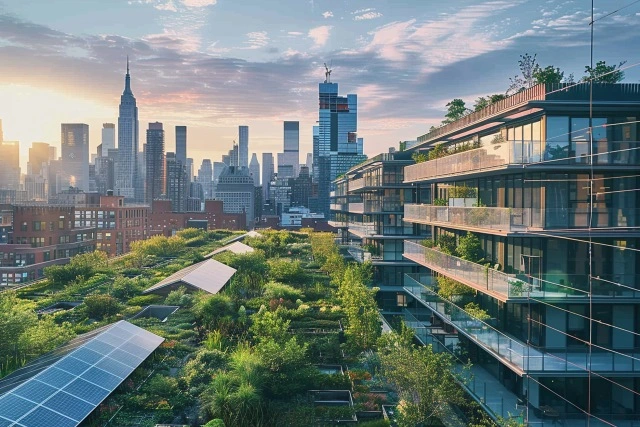The global real estate industry is committed to reducing its carbon emissions long-term. However, it faces an existential challenge to decarbonize the sector in the face of rapid urbanization. According to the International Energy Agency, the world’s building stock is expected to grow by 240 billion square meters from 2020 to 2060, the equivalent of adding a city the size of New York to the world every month for 40 years.
We are all aware that the clock is ticking for the world to mitigate the damage caused by the climate crisis and create a more sustainable environment for future generations. Therefore, it is critical that the real estate sector adopts a ‘total and holistic’ approach to reduce its carbon footprint.
Carbon reduction is not a ‘one-fix’ solution, but part of an ongoing and multi-faceted strategy. Sustainable buildings that support ambitious ESG targets should not just be an investor-led ambition but a global standard that the sector adheres to.
We have seen a fundamental shift in real estate in response to this challenge. Unsustainable, high-carbon developments are becoming undesirable to investors and tenants alike, making them harder to finance against and maintain profitability. The message is clear: decarbonize your portfolios or risk capital and ROI.
So, how can your commercial real estate (CRE) portfolio maximize the long-term value of its assets through its decarbonization strategy? This article will explain how to put your business on a roadmap to a low-carbon, sustainable, profitable future.
What is building decarbonization?
Lowering carbon emissions on a portfolio-level scale is a challenge for CRE organizations of all sizes. There is so much more to consider than energy reduction and operational efficiency. Organizations must consider all greenhouse gas emissions within their portfolio, generated both directly and indirectly. Mapping out a decarbonization strategy requires understanding everything your organization is responsible for.
CRE portfolio managers must know three main aspects of building decarbonization when creating a roadmap for lower emissions.
- Reducing operational carbon: This involves improving operational energy efficiency, switching to renewable energy sources, and electrifying heating and cooling systems.
- Reducing embodied carbon: This focuses on using low-carbon materials, minimizing waste, and optimizing the building’s design for energy efficiency.
- Life cycle assessment: Considering the entire lifespan of a building, from construction to demolition, to identify opportunities for carbon reduction.
While most efforts within CRE emissions reduction focus primarily on operational carbon, new-build developers must ensure their investments take every opportunity to lower their use of carbon at every stage of the building’s life cycle. Sustainable building design with low-carbon materials is a must in today’s ESG-led commercial landscape.
Why a sustainability roadmap is essential for your commercial portfolio
Whether you are a small/medium-sized enterprise (SME) with a modest portfolio or a multi-national organization with multiple sites in each city to manage, sustainability needs to be at the forefront of your operations.
Legislators are quickly responding to the need to reduce emissions within the built environment; the
rollout of the EU’s Corporate Sustainability Reporting Directive (CSRD) and SEC-enforced climate disclosure rules in the U.S. are clear signs that lawmakers take the sector’s climate impact seriously.
Establishing an iron-clad plan for long-term portfolio sustainability is not just essential for legal compliance; it sends a clear message to tenants and key stakeholders that your organization is prepared for the future.
In today’s hyper-competitive commercial environment, investors are more likely to fund, and tenants are more likely to renew contracts, with CRE businesses that set ambitious sustainability goals and take direct action to meet them head-on.
How to create a practical decarbonization roadmap
Every CRE organization would love to take this direct action to decarbonize their portfolio and operate a more sustainable business in the long term; it won’t be able to do this without a practical roadmap to decarbonization. This will set a clear path to reduce greenhouse gas emissions, improve energy efficiency, and enhance long-term sustainability.
This helpful chart should help with some of the critical steps your business will need to take on its path to net zero, from mapping out your portfolio’s carbon footprint to using data to track your strategy’s progress against your organization’s ESG goals.
A Nine-stage Decarbonization Roadmap |
1. Assess Your Current Carbon Footprint
|
2. Set Clear Decarbonization Goals
|
3. Develop a Strategic Plan
|
4. Implement Energy Efficiency Measures
|
5. Transition to Renewable Energy
|
6. Reduce Water Consumption
|
7. Manage Waste Effectively
|
8. Engage Stakeholders
|
9. Monitor and Measure Progress
|
The needs of your business and its real-world priorities might dictate the order of implementation for a decarbonization roadmap, but each step is important to ensure your organization and its building portfolio align with a path toward a lower-carbon future.
Utilizing ProptechOS to power your decarbonization roadmap
With any decarbonization roadmap, understanding the data behind your progress will support organizational efforts to reduce carbon across the business. With Utilize, your CRE business can draw together portfolio-scale data. Combined with wider operational efficiency gains, facilities managers can analyze real-time data from sensor-driven technology in each building they manage.
Certify, our automated certification & compliance tool can also support a decarbonization plan. With compliance renewal for environmental benchmarks such as the LEED system in-hand, your CRE business can continuously review and update performance metrics for your organization’s portfolio.
The path to decarbonization might seem overwhelming at first, particularly if your CRE business owns predominantly legacy building stock. But thanks to ProptechOS and its integrated suite of management tools, tracking your portfolio’s progress on the path to carbon reduction has never been easier.
The pillars of green building success
When we think of ‘green buildings,’ you may be inclined to imagine a state-of-the-art, glass-clad modern masterpiece – a building equipped with energy-efficient plant equipment from top to bottom. Yet that doesn’t always need to be the case.
The Empire State Building in New York, one of the world’s most iconic buildings and a champion of the 1930s art-deco style from the era it was constructed, is a LEED Gold-certified building. Thanks to a $550m refurbishment, the Empire State Realty Trust has put the landmark on a path to carbon neutrality by 2030; it is also on track to net zero across its wider portfolio by 2035.
‘Green buildings’ are more than low-carbon, energy-efficient structures; they are also designed to be healthy spaces that promote social value in the built environment. They use advanced HVAC and environmental control systems that turbocharge operational efficiency while promoting occupant health. This, in turn, increases tenant satisfaction and can add to the property’s appeal in the rental market.
Assessing your current standing
With so much commercial pressure in the market to set measurable ESG goals and demonstrate tangible progress toward more sustainable operations, businesses can easily be swept away in the debate and effectively ‘greenwash’ with unrealistic promises to investors.
Robert G. Eccles, a leading authority in the ESG space, argued in September 2024’s Harvard Business Review that businesses should be candid in their sustainability reporting, creating an honest and constructive dialogue with key stakeholders about their organization’s progress towards climate targets. CRE organizations, therefore, need to demonstrate that their decarbonization investment supports business growth and meaningful climate action instead of paying lip service in the name of ‘ESG.’
Understanding and improving your portfolio through ProptechOS
One of the simplest steps a CRE organization can take towards decarbonization and becoming a sustainability leader is to get on top of its portfolio data. With performance analytics for every aspect of the buildings you manage, it becomes much easier to spot where efficiency improvements can be made.
That’s why we created a bespoke portfolio management solution suite designed for all CRE businesses. ProptechOS solutions allow your business to gain control of your property management journey, harnessing real-time data and connecting your portfolio’s building management systems to identify improvement areas to help your business meet its decarbonization goals.
Your CRE business can sign up for a free trial today.

Per Karlberg
Per Karlberg, a distinguished technology executive, demonstrates deep expertise in the nexus of real estate, technology, and ESG. Holding advanced degrees from Lund University, and with key roles as CEO of our company and Co-Founder of ProptechOS, he has shaped the proptech field through significant contributions to real estate technology advancements. His instrumental work in co-authoring “The realestatecore ontology” has facilitated digital transformation and ESG breakthroughs in the real estate sector.
Read his full bio and information here.

